Zooarchaeology Lab
About the Lab
The Zooarchaeology Laboratory at UConn is devoted to the study of animal remains from archaeological sites. Our skeletal and taphonomic comparative collections include local New England fish, bird, and mammal species, as well as select taxa from Southwest Asia and Europe. Our modest collection (N = 125 skeletons) is intended to support teaching and small research projects.
Many of our projects concern the analysis of animal bones and teeth from Paleolithic, Epipaleolithic, and Neolithic archaeological sites in Southwest Asia and the Eastern Mediterranean. This analysis allows us to reconstruct multiple dimensions of past human behavior, including subsistence, demography, social interaction, and ritual practice.
Equipment and Facilities
The lab offers a fume hood and basic equipment necessary to process small mammals, birds, and fish. Lab space is available for students to undertake research projects, to store research collections, and to engage in analysis and study. The lab also has a Leica EZ4 stereomicroscope and an Olympus BX41 Microscope, which students are encouraged to use for their research projects.
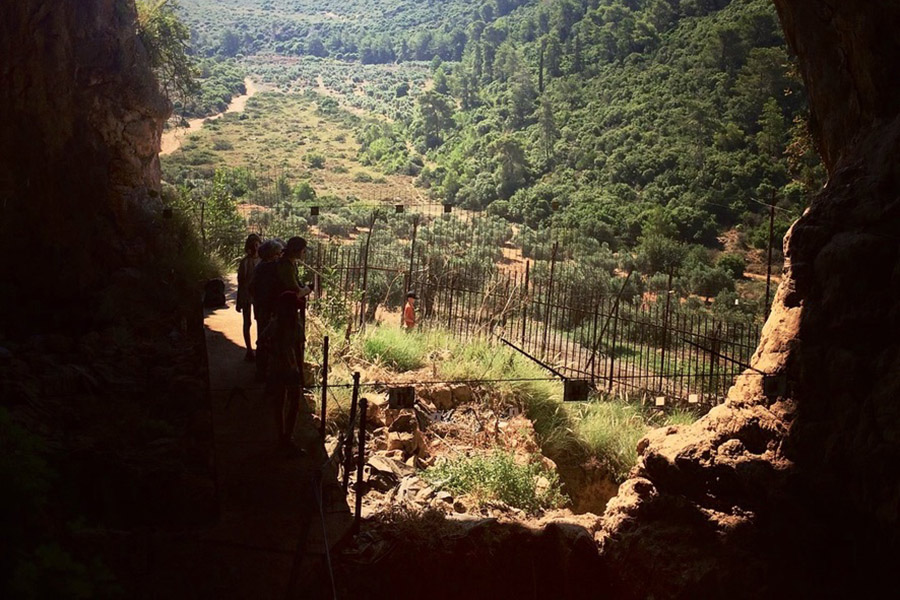 View from Hayonim Cave, Israel. (Photo courtesy Natalie Munro)
View from Hayonim Cave, Israel. (Photo courtesy Natalie Munro)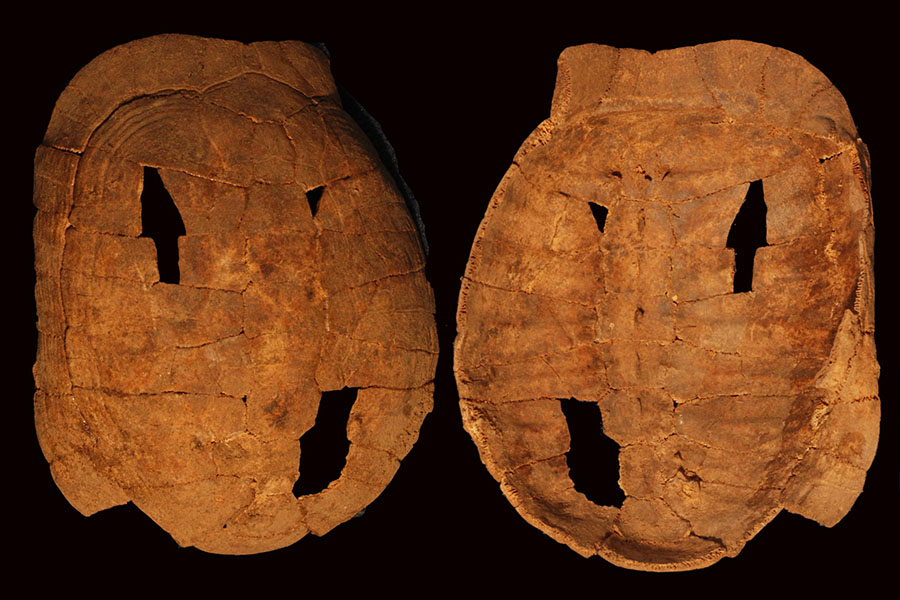 Complete tortoise carapace found in a grave at Hilazon Tachtit Cave, Israel. (Photo courtesy Gideon Hartman)
Complete tortoise carapace found in a grave at Hilazon Tachtit Cave, Israel. (Photo courtesy Gideon Hartman)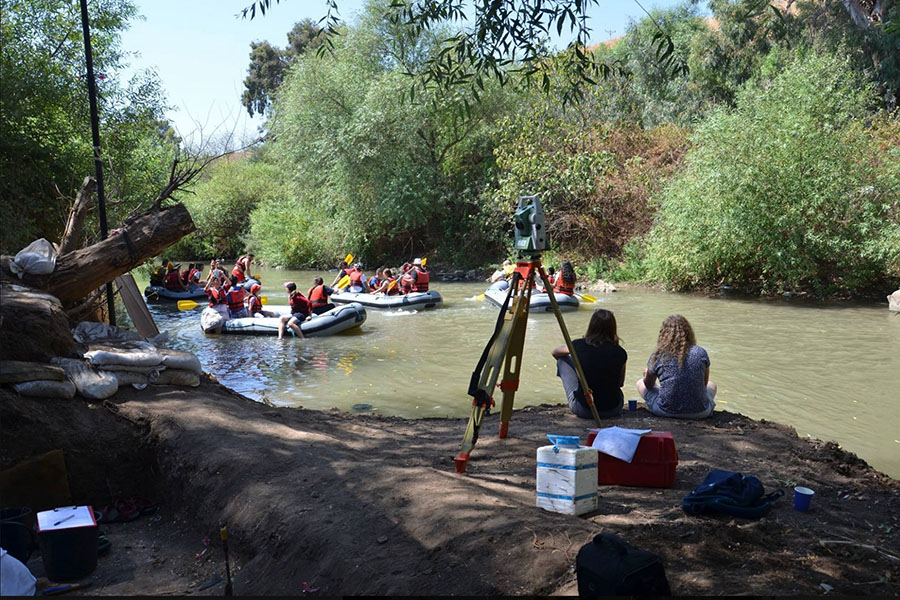 Leore Grosman and Lab Director Natalie Munro at Jordan River Dureijat on the Jordan river of Israel. (Photo courtesy Gonen Sharon)
Leore Grosman and Lab Director Natalie Munro at Jordan River Dureijat on the Jordan river of Israel. (Photo courtesy Gonen Sharon)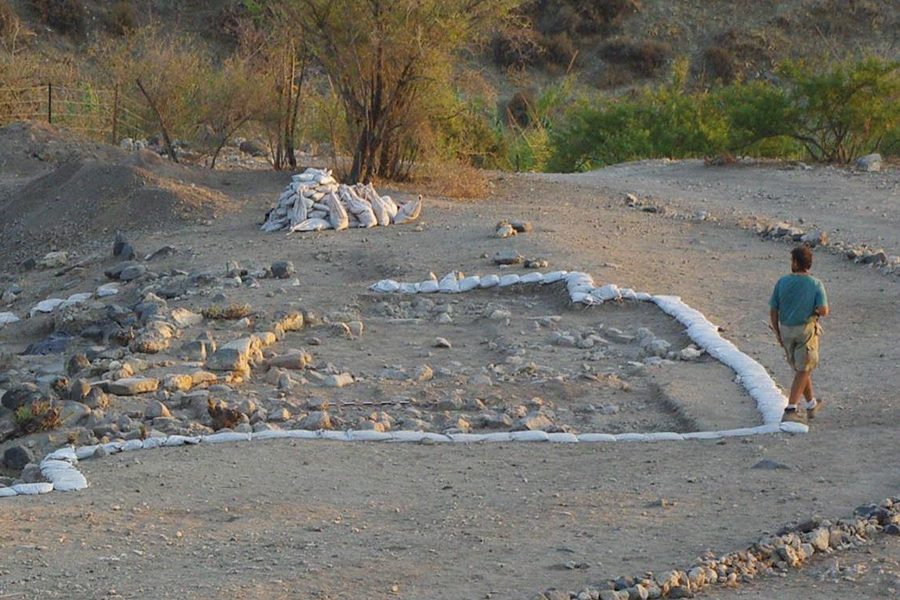 View of the Epipaleolithic site Nahal Ein Gev II, Israel. (Photo courtesy Naftali Hilger)
View of the Epipaleolithic site Nahal Ein Gev II, Israel. (Photo courtesy Naftali Hilger)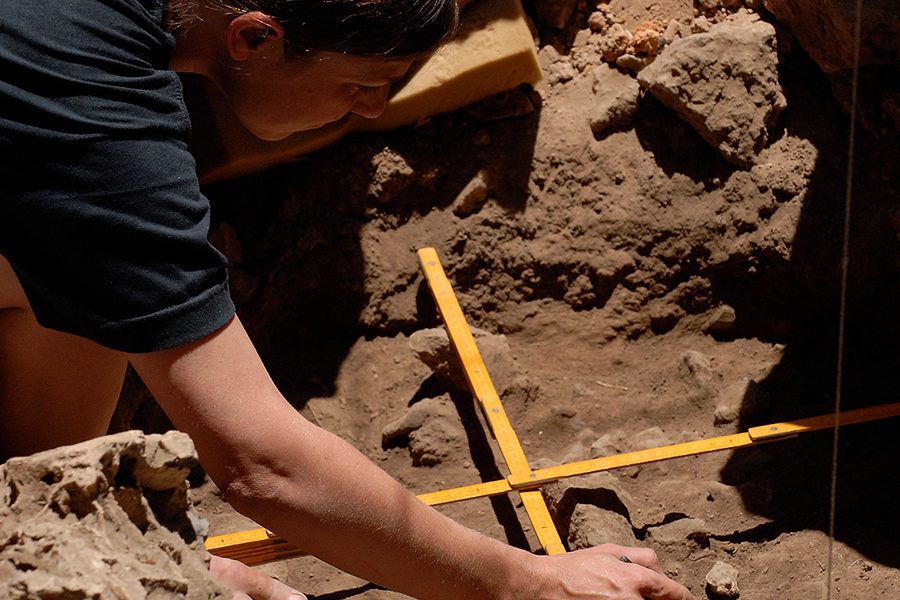 Lab director Natalie Munro excavating at Hilazon Tachtit Cave, Israel. (Photo courtesy Naftali Hilger)
Lab director Natalie Munro excavating at Hilazon Tachtit Cave, Israel. (Photo courtesy Naftali Hilger)
Current and Recent Projects
Led by director Natalie Munro, the lab's current projects revolve around three themes related to the emergence of agricultural communities.
The Formative Conditions of Agriculture: The Epipaleolithic (Natufian) Of the Southern Levant
Lab Director Natalie Munro has spent much of her career analyzing fauna from Natufian sites in Israel. This includes her dissertation site, Hayonim Cave1,2 (excavated by Ofer Bar-Yosef), François Valla’s excavations at Hayonim Terrace, the small burial cave of Hilazon Tachtit Cave3,4,5,6 (excavated by Leore Grosman) and currently the sites of Nahal Ein Gev II7,8 (also directed by Grosman) and Jordan River Dureijat9,10 (directed by Gonen Sharon). As part of these projects, Munro has applied a behavioral ecological theoretical approach to argue that animal domestication emerged out of an intensive hunting background linked to local, density-dependent demographic factors.
Citations
-
Munro, N.D. 2004. Zooarchaeological measures of hunting pressure and occupation intensity in the Natufian: implications for agricultural origins. Current Anthropology 45:S5-S33.
-
Stiner, M.C., N.D. Munro, and T.A. Surovell. 2000. The tortoise and the hare: small game use, the Broad Spectrum Revolution and Paleolithic demography. Current Anthropology 41(1): 39-73.
-
Goldgeier, H., N.D. Munro and L. Grosman. 2019. Remembering a sacred place–the depositional history of Hilazon Tachtit, a Natufian burial cave. Journal of Anthropological Archaeology 56:101111.
-
Grosman, L.G. and N.D. Munro. 2016. A Natufian ritual event. Current Anthropology 57(3): 311-331.
-
>Munro, N.D. and L. Grosman. 2010. Early evidence (12,000 BP) for feasting at a burial cave in Israel. Proceedings of the National Academy of Sciences 107(35):15362-15366.
-
Grosman, L, N.D. Munro and A. Belfer-Cohen. 2008. A 12,000 year old burial from the southern Levant (Israel): a case for early shamanism. Proceedings of the National Academy of Sciences. 105(46): 17665-17669
-
Munro, N.D., Petrillo, A.N. and Grosman, L., 2021. Specialized aquatic resource exploitation at the Late Natufian site of Nahal Ein Gev II, Israel. Archaeological and Anthropological Sciences, 13(1): 1-15.
-
Grosman L, Munro ND, Abadi I, Boaretto E, Shaham D, Belfer-Cohen A, Bar-Yosef, O. 2016. Nahal Ein Gev II, a Late Natufian Community at the Sea of Galilee. PLoS ONE 11(1): e0146647. doi:10.1371/journal.pone.0146647.
-
Pedergnana, A., Cristiani, E., Munro, N., Valletta, F. and Sharon, G., 2021. Early line and hook fishing at the Epipaleolithic site of Jordan River Dureijat (Northern Israel). PloS one, 16(10), p.e0257710.
-
Sharon, G., L. Grosman, E. Allué, A. Barash, D.E. Bar-Yosef Mayer, R. Biton, E.J. Bunin, D. Langgut, Y. Melamed, S. Mischke, F. Valleta, and N.D. Munro. 2020. Jordan River Dureijat: 10,000 Years of Intermittent Epipaleolithic Activity on the Shore of Paleolake Hula. PaleoAnthropology pp. 34-64. doi:10.4207/PA.2020.ART141
The Emergence of Animal Domestication
Munro’s projects on the emergence of animal domestication investigate new interactions between humans and animals in collaboration with colleagues (Mary Stiner, Guy Bar-Oz, Reuven Yeshurun and others) in both the southern Levant and Central Anatolia. These projects provide evidence for the in situ emergence of animal management and attest to local experimentation with animals in diverse regions within Southwest Asia.
In collaboration with Mary Stiner, Munro is part of the team working at the early Neolithic sites of Aşıklı Höyük1,2 (directed by Mihriban Özbaşaran and Güneş Duru) and Balıklı in Kapadokya, Turkey. By combining evidence from the relative abundance of different types of animals and their mortality profiles with research on animal dung and urine, animal pathologies and the architectural layout undertaken by other team members, they have documented a clear trajectory from the exploitation of wild to managed sheep over the course of about 1,000 years of occupation.
In the southern Levant, Munro investigates the emergence of animal management3 in collaboration with Lidar Sapir-Hen and Jackie Meier to examine the local emergence of goat management at the Early and Middle Pre-Pottery Neolithic sites of Yiftah’el4 (directed by Hamoudi Khalaily and Ianir Milevski) and Kfar ha Horesh5,6,7 (directed by Nigel Goring-Morris) to detect changes in the human relationship with goat, pig, and cattle, animals which were later domesticated.
Citations
-
Stiner, M.C., Munro, N.D., Buitenhuis, H., Duru, G. and Özbaşaran, M., 2022. An endemic pathway to sheep and goat domestication at Aşıklı Höyük (Central Anatolia, Turkey). Proceedings of the National Academy of Sciences, 119(4). DOI: 10.1073/pnas.2110930119
-
Stiner, M.C, H. Buitenhuis, G. Duru, S.L. Kuhn, S.M Mentzer, N.D. Munro, N. Pollath, J. Quade, G. Tsartsidou and M. Ozbaşaran. 2014. A forager–herder trade-off, from broad-spectrum hunting to sheep management at Aşıklı Höyük, Turkey. Proceedings of the National Academy of Sciences 111 (23): 8404-8409.
-
Munro, N.D, G Bar-Oz, JM Meier, L. Sapir-Hen, MC Stiner, R. Yeshurun. 2018. The emergence of animal management in the southern Levant. Scientific Reports 8:9279; DOI:10.1038/s41598-018-27647-z.
-
Sapir-Hen, L, T. Dayan, H. Khalaily and N.D. Munro. 2016. Human Hunting and Nascent Animal Management at Middle Pre-Pottery Neolithic Yiftah'el, Israel. PLoS ONE 11(7): e0156964. doi:10.1371/journal.pone.0156964
-
Meier, J.M., N. Goring-Morris and N.D. Munro. 2017. Aurochs bone deposits at Kfar HaHoresh and the southern Levant across the agricultural transition (22,000–8,350 cal. BP). Antiquity 91(360):1469-1483.
-
Meier, J.M., N. Goring-Morris and N.D. Munro. 2017. Depositional Histories of Faunal Remains from the Neolithic Cultic Site of Kfar HaHoresh, Israel. Journal of Archaeological Anthropology 48:233-249.
-
Meier, J.M., N.Goring-Morris and N.D. Munro. 2016. Provisioning the Ritual Neolithic Site of Kfar HaHoresh, Israel at the Dawn of Animal Management. PLoS ONE 11(11): e0166573. DOI: 10.1371/journal.pone.0166573.
The Spread of Agriculture to the Eastern Mediterranean
Finally, in collaboration with Mary Stiner, Munro analyzed a large assemblage of fauna originating from the Upper Paleolithic through the Neolithic periods from the remarkable site of Franchthi Cave1,2,3 in the Peloponnese of Greece. As part of this project they documented evidence for increased site intensity alongside an expansion in dietary breadth first in the terrestrial and then in the aquatic game component culminating in the Mesolithic period. Franchthi Cave also includes an intact Mesolithic-Neolithic sequence which enabled them to capture the rapid and early spread of agriculture to this locale early in the Neolithic period.
Citations
-
Munro, N.D. and M.C. Stiner. 2020. A zooarchaeological history of the Neolithic occupations at Franchthi Cave and paralia in southern Greece. Journal of Anthropological Archaeology 58:101162.
-
Munro, N.D. and M.C. Stiner. 2015. Zooarchaeological evidence for Early Neolithic colonization at Franchthi Cave (Peloponnese, Greece). Current Anthropology 56(4): 596-603.
-
Stiner, M.C. and N.D. Munro. 2011. On the Evolution of Diet and Landscape during the Upper Paleolithic through Mesolithic at Franchthi Cave (Peloponnese, Greece). Journal of Human Evolution 60(5):618-636.
In addition to research related to these three themes, Munro continues to work in Greece at the Middle Paleolithic site of Panthera Cave on the Island of Kythros (excavated by Nena Galanidou).
Selected Publications
Stiner, M.C., Munro, N.D., Buitenhuis, H., Duru, G. and Özbaşaran, M., 2022. An endemic pathway to sheep and goat domestication at Aşıklı Höyük (Central Anatolia, Turkey). Proceedings of the National Academy of Sciences, 119(4). DOI: 10.1073/pnas.2110930119
Lebenzon, R. and Munro, N.D. 2022. Body size variation in a modern collection of mountain gazelle (Gazella gazella) skeletons. Journal of Archaeological Science: Reports 41:103285.
Munro, N.D., Petrillo, A.N. and Grosman, L., 2021. Specialized aquatic resource exploitation at the Late Natufian site of Nahal Ein Gev II, Israel. Archaeological and Anthropological Sciences, 13(1): 1-15.
Munro, N.D. and M.C. Stiner. 2020. A zooarchaeological history of the Neolithic occupations at Franchthi Cave and paralia in southern Greece. Journal of Anthropological Archaeology 58:101162.
Munro, N.D, G Bar-Oz, JM Meier, L. Sapir-Hen, MC Stiner, R. Yeshurun. 2018. The emergence of animal management in the southern Levant. Scientific Reports 8:9279; DOI:10.1038/s41598-018-27647-z.
For more information about Professor Munro’s research, please visit the followings sites:
Our Team
Lab Director
Graduate Students
Contact Us
| E-mail: | natalie.munro@uconn.edu |
|---|---|
| Address: | Beach Hall Room 451 354 Mansfield Road Unit 1176 Storrs, CT 06269-1176 |